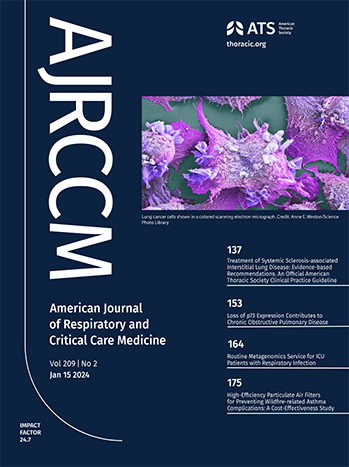Randomized Sham Controlled Trial of Targeted Lung Denervation in Patients with COPD (AIRFLOW-3).
IF 19.4
1区 医学
Q1 CRITICAL CARE MEDICINE
American journal of respiratory and critical care medicine
Pub Date : 2025-09-08
DOI:10.1164/rccm.202502-0404oc
引用次数: 0
Abstract
RATIONALE AIRFLOW-3 was a 1:1 randomized, double blind, sham controlled trial of the d'Nerva Targeted Lung Denervation (TLD) System in patients with COPD. OBJECTIVE Evaluate the impact of TLD on COPD exacerbations compared to optimal medical treatment. METHODS AIRFLOW-3 patients were symptomatic (CAT ≥10) with moderate to very severe airflow obstruction (25% ≤ FEV1 ≤ 80% predicted) and GOLD E status (≥2 moderate or ≥1 severe exacerbation over prior 12 months). The primary endpoint was comparison of time-to-first moderate or severe COPD exacerbation through 12 months between the Treatment (TLD + optimal medical treatment) and Sham Control groups (sham procedure + optimal medical treatment). Secondary endpoints included rate of severe COPD exacerbations, change in quality of life (SGRQ-C and SF-36), change in lung function (FVC, FEV1, RV), and change in CAT. MEASUREMENTS AND MAIN RESULTS 388 patients were randomized 1:1 at 32 sites. There was no difference between TLD compared to sham treatment in probability of participants having a moderate or severe COPD exacerbation, HR 1.268 (95% CI, 0.988 to 1.628). At 1 year, the TLD group had less dyspnea (> 1 point improvement in TDI 35.4 vs 24.1%, p 0.021) compared to sham. Post-hoc analyses revealed that failure to reach the primary endpoint was driven by an insufficient number of patients exhibiting an airway-predominant phenotype (lung hyperinflation without significant emphysema). CONCLUSIONS AIRFLOW-3 failed to meet its primary endpoint. However, post-hoc analyses identified a responder profile; a prospective multicenter randomized controlled trial is being designed to confirm these findings.COPD患者靶向肺去神经的随机假对照试验(AIRFLOW-3)。
RATIONALEAIRFLOW-3是一项1:1随机、双盲、假对照试验,旨在研究神经靶向肺去神经(TLD)系统在COPD患者中的应用。目的评价TLD与最佳药物治疗相比对COPD加重的影响。方法sairflow -3患者有症状(CAT≥10),伴有中度至极重度气流阻塞(25%≤FEV1≤80%预测)和GOLD E状态(过去12个月≥2次中度或≥1次重度加重)。主要终点是比较治疗组(TLD +最佳药物治疗)和假对照组(假手术+最佳药物治疗)12个月内首次出现中度或重度COPD恶化的时间。次要终点包括严重COPD加重率、生活质量变化(SGRQ-C和SF-36)、肺功能变化(FVC、FEV1、RV)和CAT变化。388例患者以1:1的比例在32个地点随机分组。TLD组与假手术组相比,受试者发生中度或重度COPD加重的概率无差异,HR为1.268 (95% CI, 0.988 ~ 1.628)。1年时,与假手术组相比,TLD组呼吸困难较少(TDI改善bb0.1点,35.4 vs 24.1%, p 0.021)。事后分析显示,未能达到主要终点是由于表现出气道显性表型(肺恶性膨胀无明显肺气肿)的患者数量不足所致。结论sairflow -3未能达到其主要终点。然而,事后分析确定了应答者概况;正在设计一项前瞻性多中心随机对照试验来证实这些发现。
本文章由计算机程序翻译,如有差异,请以英文原文为准。
求助全文
约1分钟内获得全文
求助全文
来源期刊
CiteScore
27.30
自引率
4.50%
发文量
1313
审稿时长
3-6 weeks
期刊介绍:
The American Journal of Respiratory and Critical Care Medicine focuses on human biology and disease, as well as animal studies that contribute to the understanding of pathophysiology and treatment of diseases that affect the respiratory system and critically ill patients. Papers that are solely or predominantly based in cell and molecular biology are published in the companion journal, the American Journal of Respiratory Cell and Molecular Biology. The Journal also seeks to publish clinical trials and outstanding review articles on areas of interest in several forms. The State-of-the-Art review is a treatise usually covering a broad field that brings bench research to the bedside. Shorter reviews are published as Critical Care Perspectives or Pulmonary Perspectives. These are generally focused on a more limited area and advance a concerted opinion about care for a specific process. Concise Clinical Reviews provide an evidence-based synthesis of the literature pertaining to topics of fundamental importance to the practice of pulmonary, critical care, and sleep medicine. Images providing advances or unusual contributions to the field are published as Images in Pulmonary, Critical Care, Sleep Medicine and the Sciences.
A recent trend and future direction of the Journal has been to include debates of a topical nature on issues of importance in pulmonary and critical care medicine and to the membership of the American Thoracic Society. Other recent changes have included encompassing works from the field of critical care medicine and the extension of the editorial governing of journal policy to colleagues outside of the United States of America. The focus and direction of the Journal is to establish an international forum for state-of-the-art respiratory and critical care medicine.

 求助内容:
求助内容: 应助结果提醒方式:
应助结果提醒方式:


